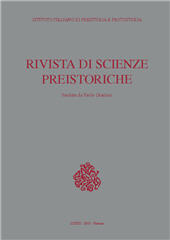Teorie e nuovi metodi per la revisione dell'arte mobiliare paleolitica : il caso di Grotta Romanelli e il progetto Dec.O.
P. 1-30
Grotta Romanelli (GR) (Castro, LE) has yielded the most consistent heritage of Palaeolithic portable art in Italy. The finds that fall into this class of objects number over 200 and express a wide variability not only in terms of the type of support (rock and bone), but even thematically, stylistically and technologically. The intense artistic activity between the end of the Pleistocene and the beginning of the Holocene in this coastal cave has been known since the first archaeo-paleontological investigations, in the early 20th century. The impressive record of portable and parietal art made GR a reference site in the Palaeolithic studies within a few decades, together with some Spanish caves, i.e. Parpallò and La Pileta, and French sites, i.e. Baume-Latrone and Ebbou. This led soon to theorise the existence of a "Mediterranean artistic province", within which GR, thanks to its geographical location, acted as a connecting point between different artistic trends.
However, studies in recent decades have shown that this paradigm in now largely outdated. The start of new research activities and a new attention paid to the artistic evidence of this site, made it urgent to systematically review the symbolic production, which had not been the subject of new critical studies for over fifty years. This urgency materialised in the launch of the research project "Dec.O. - Decorated Objects of Romanelli Cave, a key site of the late Pleistocene-early Holocene Mediterranean area", which is funded by the Fyssen Foundation, and aims to investigate the dynamics in the imagery on portable art and rock art in deep-time and the past socio-cultural influences and borders between western and southern Europe and the regions overlooking the Mediterranean Sea.
The projects considers, then, the small-to-large scale cultural geographies of the last European Upper Palaeolithic fisher-hunter-gatherer societies and, focusing on portable art of a key-site such as Grotta Romanelli, at the border of what has traditionally been considered the core-zone of the Palaeolithic art tradition, i.e. western Europe, it addresses the issue of cultural change, resilience and continuity between 21-11,5 kya cal. BP. In order to achieve these objectives, a documentation method was established and is described here, together with the series of analyses and theories adopted for the global study of the corpus of portable art from Grotta Romanelli. Furthermore, by presenting a precise description of all the steps taken, which would certainly be useful for any other coherent and systematic study of Palaeolithic portable art, this work aims to become a first reference for future studies in this field, given the lack of similar publications in the Italian literature. [Publisher's text]
Fait partie de
Rivista di scienze preistoriche : LXXIII, 2023-
Articles du même numéro (disponibles individuellement)
-
-
Informations
Code DOI : 10.32097/1217
ISSN: 2282-457X
KEYWORDS
- Arte paleolitica, Arte mobiliare, Metodologia, Documentazione, Tecniche analitiche
- Palaeolithic art, Portable art, Methodology, Documentation, Analytical techniques


